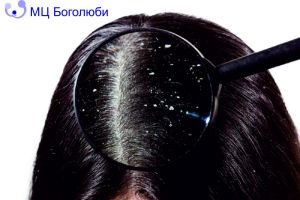Many people know what dandruff (scruf) is, but not everyone knows that it is actually a sign of seborrheic dermatitis, which can manifest not only on the scalp, but also on other areas of the body, especially those that are rich in glandulae sebaceae. The disease is not contagious, but it has a negative impact on social relationships and quality of life.
Seborrheic dermatitis – is an inflammation of the skin characterized by the presence of yellowish and fatty scales associated with itching and redness. Often the back surface of the ears, ear canal, eyebrows, breasts are affected. The disease affects approximately 5% of the world's population and is a recurrent chronic trend characterized by periods of remission and exacerbation that occur with variable frequency.
In particular, the condition improves in the summer and worsens in the winter. Men are more susceptible to the disease, especially in childhood and adolescence. In babies, dermatitis on the scalp can appear from the first days of life and is defined as gneiss or milky venom. It occurs in 70% of newborns within the first three months of life, in some cases associated with the appearance of diaper rash.
Reasons of Seborrheic dermatitis
The causes of the disease are not clear yet. Although it is known that increased production of sebaceous glands is a deciding factor. The disease usually begins to manifest itself from the pubertal period of age, in which there is an increase in the production of sebum. Its synthesis is stimulated by androgens and inhibited by estrogens. (This explains the high incidence of seborrheic dermatitis among men.)
An important role is also played by fungi of the genus Malassezia. It is known that they are part of the permanent microflora of the skin. Scientific observations have shown that episodes of spontaneous transition of a fungus of one morphological type to another occur. This led to the conclusion that the main «culprit» of dandruff Pityrosporum ovale and Malassezia furfur are simply different variations of the same kind of fungus. Under favorable conditions (hyperfunction of the sebaceous glands, zinc deficiency, immunosuppression), the pathogenicity of the fungus increases and, as a result, we get an inflammatory skin reaction;
A likely factor predisposing to dermatitis on the scalp is a lack of vitamins such as biotin (vitamin B8) and pyridoxine (vitamin B6). There is also a genetic predisposition to the disease.
Symptoms of Seborrheic dermatitis
In the classic form disease is accompanied by the appearance of red spots with torn edges and poorly defined borders, covered with oily scales that are easily removed. Sometimes real crusts are present. The lesions are localized in the front line of hair growth and have different sizes. Often the illness is associated with itching, which is very intense, causing a burning sensation. Symptoms tend to build up gradually.
How to treat Seborrheic dermatitis?
It is important to remember that seborrheic dermatitis of the scalp is a chronic disease. In this regard, the long-term results of any type of treatment should be carefully considered, whether it is pharmacological medicines prescribed by a dermatologist, or local remedies - shampoos and lotions.
The main therapeutic objective is to reduce the inflammatory response, overproduction of sebum and the colonization of Malassezia fungi.
When signs of seborrheic dermatitis appear, in order to gain control over the symptoms, it is necessary to contact a dermatologist-trichologist on time. Specialists of the Bogoliuby MC warn that with seborrheic dermatitis, hair should not be washed too often, as this excessively stimulates the secretion of sebaceous glands. The use of non-aggressive cosmeceutical products that can remove sebum without changing the hydrolipidic film of the scalp is of fundamental importance.
A leading aspect that should never be overlooked is proper nutrition. The patient should avoid foods containing high amounts of saturated fats and sugars, as well as yeast baked goods and dairy foods. Among the most useful natural remedies that can limit the manifestations of the disease is the gradual and controlled exposure to sunlight. During periods of increased psychophysical stress, various relaxation techniques, yoga, sports, and, of course, a good sleep can become useful.

















